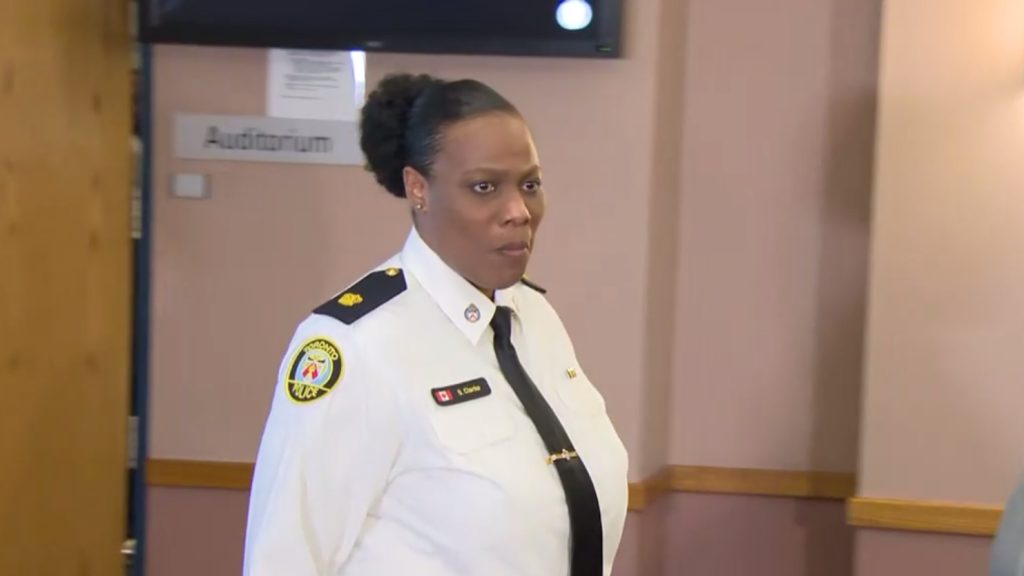Former Newfoundland legislature and site of 1932 riot gets $22M facelift
Posted July 27, 2014 10:00 am.
This article is more than 5 years old.
ST. JOHN’S, N.L. – There’s a good story behind the spectacular ceiling frescoes now brought back to full glory as part of a $22-million restoration of Newfoundland’s former legislature.
The intricate patterns that embellish twin chambers where elected and appointed officials once governed the British colony turned dominion then Canadian province were painted by a Polish artist serving time for forgery.
It’s perhaps the least you’d expect from one of the most fabled buildings in St. John’s, N.L. — a place that calls itself the City of Legends.
Jerry Dick, director of heritage for the provincial Tourism, Culture and Recreation Department, tells the tale of Alexander Pindikowski. The gifted artist wound up in Her Majesty’s Penitentiary for 15 months in 1880 after forging cheques.
Rather than have his talents go to waste, his sentence was partly commuted in exchange for creating resplendent ceiling murals at the Colonial Building and other prominent sites around the city.
“There are lots of interesting things about this building,” Dick said of the neoclassical structure that first opened in 1850. A triangular pediment dominates the exterior supported by six stone columns.
The restoration to be finished by the fall of next year will transform the front lobby back to 1850 with faux marble and wood paint finishes considered among the finest of the day, Dick said.
Inside, the elected house of assembly and appointed legislative council chambers will be taken back to 1880 to showcase Pindikowski’s stunning handiwork.
“There will be the desks of the legislators and we plan to use this space for things like historical re-enactments,” Dick said. “We also see youth parliaments, debates and … even special sittings of the house of assembly.”
The storied site hasn’t functioned as a legislature since just before provincial politicians relocated to the Confederation Building in 1960. It served as the provincial archives until 2005 and has since been maintained but mostly empty.
The $22.3-million revamp is being largely funded by the province with the federal government contributing just over $9 million.
Dick clearly enjoys pointing out the building’s unique features. There’s the staircase down which former prime minister Richard Squires escaped on April 5, 1932 as a riot raged outside over suspected government corruption and mismanagement. Newspaper accounts described how Squires was chased by the crowd into a nearby residence from which he narrowly fled.
The incensed mob shattered the legislature windows and trashed furniture, causing extensive damage. Attempts to burn it down failed.
Happier times at the Colonial Building included lavish parties.
“We found a stash of champagne bottles that were probably from the 19th century,” Dick said.
Shane O’Dea, a heritage advocate who has helped advise the project, recounted a list of pivotal events marked inside or on the steps of the old legislature.
“It is the site where we established responsible government in 1855, from which we declared the First World War in 1914 a century ago and then in 1932 there was that dreadful riot,” he said.
“But probably the most important thing to occur in that building was the national convention.”
O’Dea was referring to emotional, divisive debates between 1946 and 1948 about Newfoundland’s future governance. A thin referendum vote majority ultimately saw Newfoundland join Confederation, becoming Canada’s 10th province in 1949.
It officially became Newfoundland and Labrador through a 2001 amendment to the Constitution.
Stephanie Hoagland, a senior associate with New York-based Jablonski Building Conservation Inc., assessed layers of paint finishes at the Colonial Building dating back to 1850.
“What we found was so incredibly highly skilled. And it was patterns that I hadn’t seen before.”
Dick said a wall in one of the upper offices revealing stencil designs and paint colours over the decades will be preserved to show how the decor evolved. The grounds will be restored to an original open forecourt with a historic wrought iron fence and gate.
But Dick said the Colonial Building will be very much a public place.
“I would like every young person in Newfoundland and Labrador to really understand their own political history. But also we want to use this building to help people understand better our political processes, our parliamentary system and some of the ritual and so forth that goes with that.”
Follow @suebailey on Twitter.










